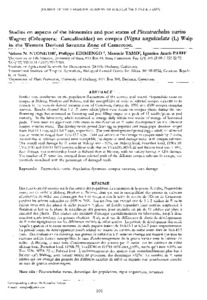| dc.contributor.author | Ntonifor, N.N. |
| dc.contributor.author | Edimengo, P. |
| dc.contributor.author | Tamo, M. |
| dc.contributor.author | Parh, I.A. |
| dc.date.accessioned | 2019-12-04T11:23:41Z |
| dc.date.available | 2019-12-04T11:23:41Z |
| dc.date.issued | 2005 |
| dc.identifier.citation | Ntonifor, N.N., Edimengo, P., Tamo, M. & Parh, I.A. (2005). Studies on aspects of the bionomics and pest status of Piezotrachelus varius Wagner (Coleoptera: curculionidae) on cowpea (Vigna unguiculata (L) walp in the western derived savanna zone of Cameroon. Journal of the Cameroon Academy of Sciences, 5(2), 101-107. |
| dc.identifier.uri | https://hdl.handle.net/20.500.12478/4107 |
| dc.description.abstract | Studies were conducted on the population fluctuations of the cowpea pod weevil, Piezotrachelus varius on cowpea at Melong, NY(lkon and Babessi, and the susceptibility of seeds of selected cowpea cultivars to its damage in the western derived savanna zone of Cameroon, during the 1999 and 2000 cowpea cropping seasons. Results showed that 1-2 P. varius adults/plant were found on cowpea plants during the pret10wering stage but increased at flowering and pod filling stages to a peak of 11 adults/plant at pod maturity. In the laboratory, adults continued to emerge daily within two weeks of storage of harvested pods. There were no significant differences in the duration of P. varius development on the different cowpea varieties tested. The developmental period from egg to pupation and mean pupal duration ranged from 10.4-11.1 days and 6.3-6.7 days, respectively. The total developmental period (egg - adult) on all tested cowpea varieties ranged from 16.6-17.7 days. Field evaluations of the damage to cowpea seeds by P. varius, showed that all cultivars screened were susceptible; the degree of seed damage varied with cowpea cultivars. The overall seed damage by P. varius at Melong was =50%, on Melong local, Foumbot local, IT90k-59, TVu13740 and IT87D-1676 cowpea cultivar while that on TVu3236, MTA 22 and Babessi local was < 50%. Seed damage was considerably lower at Babessi than at Melong, with no variety having> 12% damage. The number of P. varius that emerged from infested pods of the different cowpea cultivars in storage, was positively co-related with the percentage of damaged seeds. |
| dc.description.sponsorship | Swiss Agency for Development and Cooperation |
| dc.format.extent | 101-107 |
| dc.language.iso | en |
| dc.subject | Population Dynamics |
| dc.subject | Cowpeas |
| dc.subject | Varieties |
| dc.subject | Seed Damaging Insects |
| dc.title | Studies on aspects of the bionomics and pest status of Piezotrachelus varius Wagner (Coleoptera: curculionidae) on cowpea (Vigna unguiculata (L) walp in the western derived savanna zone of Cameroon |
| dc.type | Journal Article |
| dc.description.version | Peer Review |
| cg.contributor.affiliation | University of Buea |
| cg.contributor.affiliation | Institute of Agricultural Research for Development |
| cg.contributor.affiliation | International Institute of Tropical Agriculture |
| cg.contributor.affiliation | Université de Dschang |
| cg.coverage.region | Africa |
| cg.coverage.region | Central Africa |
| cg.coverage.country | Cameroon |
| cg.creator.identifier | Manuele Tamò: 0000-0002-5863-7421 |
| cg.authorship.types | CGIAR and developing country institute |
| cg.iitasubject | Cowpea |
| cg.iitasubject | Pests Of Plants |
| cg.iitasubject | Plant Health |
| cg.iitasubject | Plant Production |
| cg.journal | Journal of the Cameroon Academy of Sciences |
| cg.howpublished | Formally Published |
| cg.accessibilitystatus | Open Access |
| local.dspaceid | 99540 |
| cg.targetaudience | Scientists |

